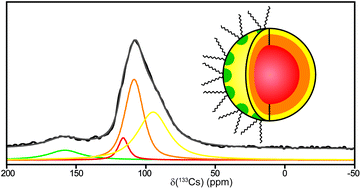Structure and surface properties of size-tuneable CsPbBr3 nanocrystals†
Abstract
This investigation has characterised the structure and surface chemistry of CsPbBr3 nanocrystals with controlled diameters between 6.4 to 12.8 nm. The nanocrystals were investigated via a thorough 133Cs solid state NMR and nuclear relaxation study, identifying and mapping radially-increasing nanoscale disorder. This work has formalised 133Cs NMR as a highly sensitive probe of nanocrystal size, which can conveniently analyse nanocrystals in solid forms, as they would be utilised in optoelectronic devices. A combined multinuclear solid state NMR and XPS approach, including 133Cs–1H heteronuclear correlation 2D (HETCOR) NMR, was utilised to study the nanocrystal surface and ligands, demonstrating that the surface is Cs–Br rich with vacancies passivated by didodecyldimethylammonium bromide (DDAB) ligands. Furthermore, it is shown that a negligible amount of phosphonate ligands remain on the powder nanocrystal surface, despite the key role of octylphosphonic acid (OPA) in controlling the colloidal nanocrystal growth. The CsPbBr3 NCs were shown to be structurally stable under ambient conditions for up to 6 months, albeit with some particle agglomeration.



 Please wait while we load your content...
Please wait while we load your content...